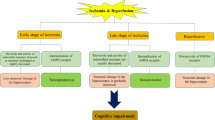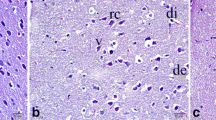Abstract
Rats were subjected to bilateral carotid artery occlusion for 30 min, followed by reperfusion for varying time periods. The concentration of reduced and oxidized glutathione, glutathione peroxidase and glutathione reductase were determined in whole brain after varying periods of reperfusion. Lipid peroxidation was also assessed by determining the levels of malondialdehyde (MDA) in the brain. Reperfusion for 1 hr following bilateral carotid artery occlusion resulted in significant decrease in total glutathione (GSH) concentration along with small but significant increase in oxidized glutathione (GSSG) levels. After 4 hr of reperfusion, GSH levels recovered, although GSSG levels remained elevated up to 12 hr of reperfusion. Increase in malondialdehyde levels was also detected in the brain up to 12 hr of reperfusion. Glutathione reductase activity remained significantly low up to 144 hr of reperfusion, while glutathione peroxidase activity remained unaffected. These results demonstrate that oxidative stress is generated in the brain during reperfusion following partial ischemia due to bilateral carotid artery occlusion.
Similar content being viewed by others
References
Siesjo BK: Cell damage in the brain: A speculative synthesis. J Cereb Blood Flow Metab 1: 155–185, 1981
Demopoulos H, Flamm E, Seligmann M, Power R, Pietronigro D, Ransohoff J: Molecular pathology of lipids in CNS membranes. In: FF Jobsis (ed.) Oxygen and Physiological Function. Professional Information Library, Dallas, 1977, pp 491–508
Flamm ES, Demopoulos HB, Seligman ML, Poser RG, Ransohoff J: Free radicals in cerebral ischemia. Stroke 9: 445–447, 1978
Rehncrona S, Mela L, Siesjo BK: Recovery of brain mitochondrial function in the rat after complete and incomplete cerebral ischemia. Stroke 10: 437–446, 1979
Granger DN, Hollwarth ME, Parks DA: Ischemia reperfusion injury: Role of oxygen derived free radicals. Acta Physiol Scand 548 (Suppl): 47–63, 1986
Kogure K, Watson BD, Busto R, Abe K: Potentiation of lipid peroxides by ischemia in rat brain. Neurochem Research 7: 437–454, 1982
Watson BD, Busto R, Goldberg WJ, Santiso M, Yoshida S, Ginsberg MD: Lipid peroxidation in vivo induced by reversible global ischemia in rat brain. J Neurochem 42: 268–274, 1984
Yoshidda S, Inoh S, Asano T, Sano K, Kubota M, Shimazaki H, Ueta N: Effect of transient ischemia on free fatty acids and phospholipids in the gerbilbrain. J Neurosurg 53: 323–331, 1980
Rehncrona S, Westerberg E, Akesson B, Siesjo BK: Brain cortical fatty acids and phospholipids during and following complete and severe incomplete ischemia. J Neurochem 38: 84–93, 1982
Eklof B, Siesjo BK: The effect of carotid artery ligation upon the blood flow and energy state of the rat brain. Acta Physiol Scand 86: 155–165, 1972
Meister A, Anderson ME: Glutathione. Ann Rev Biochem 52: 711–760, 1983
Smith AC, Boyd MR: Preferential effects of 1, 3 bis (2-Chloroethyl)-1-nitrosourea (BCNU) on pulmonary glutathione reductase and glutathione/glutathione disulfide ratios: Possible implications for lung toxicity. J Pharm Exp Ther 229: 658–663, 1984
Rehncrona S, Folbergrova J, Smith DS, Siesjo BK: Influence of complete and pronounced incomplete cerebral ischemia and subsequent recirculation on cortical concentrations of oxidized and reduced glutathione in the rat. J Neurochem 34: 477–486, 1980
Cooper AJL, Pulsinelli WA, Duffy TE: Glutathione and ascorbate during ischemia and postischemic reperfusion in rat brain. J Neurochem 35: 1242–1245, 1980
Akerboom TPM, Sies H: Assay of glutathione, glutathione disulfide and glutathione mixed disulfides in biological samples. In: WB Jakoby (ed.) Methods in Enzymology. Academic Press, New York, 1981, 77: 373–382
Tietze F: Enzymatic method for quantitative determination of nanogram amounts of total and oxidized glutathione: Applications to mammalian blood and other tissues. Anal Biochem 27: 502–522, 1969
Ohkawa H, Ohishi N, Yagi K: Assay of lipid peroxides in animal tissues by thiobarbituric acid reaction. Anal Biochem 95: 351–358, 1979
Wendel A: Glutathione peroxidase. In: WB Jakoby (ed.) Methods in Enzymology. Academic Press, New York, 1981, 77: 325–333
Horn HD: Glutathione reductase. In: HV Bergmeyer (ed.) Methods in Enzymatic Analysis. 1965, 1: 875–879
Bradford MM: A rapid and sensitive method for the quantitation of microgram quantities of protein utilizing the principle of protein dye binding. Anal Biochem 72: 248–254, 1976
Bose R, Sutherland GR, Pinsky C: Biological and methodological implications of prostaglandin involvement in mouse brain lipid peroxidation measurements. Neurochem Research 14: 217–221, 1989
Ravindranath V, Reed DJ: Glutathione depletion and formation of glutathione protein mixed disulfides following exposure of brain mitochondria to oxidative stress. Biochem Biophys Res Commun 169: 1075–1079, 1990
Author information
Authors and Affiliations
Rights and permissions
About this article
Cite this article
Shivakumar, B.R., Kolluri, S.V.R. & Ravindranath, V. Glutathione homeostasis in brain during reperfusion following bilateral carotid artery occlusion in the rat. Mol Cell Biochem 111, 125–129 (1992). https://doi.org/10.1007/BF00229583
Issue Date:
DOI: https://doi.org/10.1007/BF00229583




